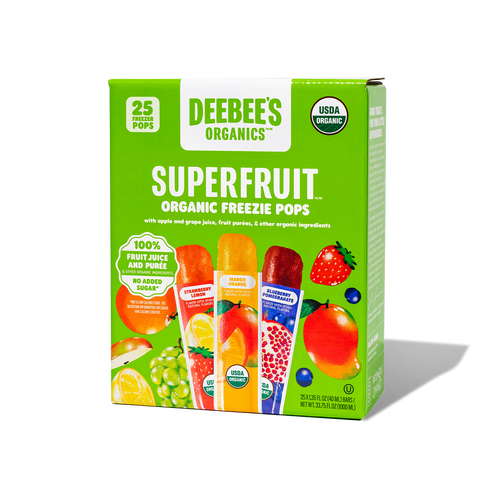With the appearance of spring comes one of our favorite times of year at DeeBee’s: planting season!
The benefits of getting outside to grow your own food are endless, and we are so excited to share our favorite foods to grow this year. From fruits and vegetables to flowers and herbs, learn how gardening promotes gratitude and brings families closer together.
How Gardening Fosters Gratitude
When a large majority of what we consume comes from grocery stores, it can be easy to forget about the journey each ingredient on a plate has taken to reach our table. A simple act like giving thanks before a meal can be a powerful way to express gratitude for food. But how can we foster this gratitude before we even sit down to eat?
Our favorite way to do this is by gardening! By involving ourselves in the process of food as much as we can, we can not only foster more thankfulness for food, but bring about more happiness, too. We like to call this our garden of gratitude! Gardening can help us begin to hold more thankfulness for aspects of nature that are often overlooked, like
- Rainy days (they water our plants so we don’t need to!)
- Bugs and worms (they help aerate soil and recycle nutrients)
- Fallen leaves, sticks, pinecones and other scraps (they can help fertilize the earth and speed growth)
- Fruits and vegetables that don’t look “perfect” like at a grocery store (because we discover they are just as tasty!)
The best part? You don’t need much space or time to start growing your own food, and we’re here to share our favorite beginner-friendly fruits to grow with kids!
The Benefits of Gardening with Children
Contrary to common belief, gardening is meant for everyone. In addition to being an easy way to foster gratitude, gardening with the children in your life holds several benefits (for both them and you!) Curious to hear about our favorites?
- Regular exposure to the sun when gardening increases vitamin D, kills bacteria, and boosts moods!
- Gardening can improve young children's’ hand-eye coordination, and foster curiosity in the world. This in turn encourages their sensory and cognitive development, since gardening stimulates all five senses.
- The routine of gardening tasks (watering plants, pulling weeds, etc.) is known to be a great stress and anxiety reliever for both children and adults.
- Gardening is a great way to bond with a child by working towards a common goal. For children, doing the same tasks as you (and with you!) can improve their self-worth, ease their mind, and help them open up about emotions.
- The act of watching food grow from seed to harvest provides children with an early understanding of where their food comes from. In fact, this makes them more likely to enjoy eating their fruits and veggies!
- Gardening is also a form of exercise (think lifting watering cans, digging holes, and pulling weeds) that provides children with a routine reason to get outdoors and move their bodies.
- It’s an inexpensive way to have fun! Other than the start-up costs of seeds and gardening tools (which can be bought second-hand,) gardening at home is fairly low-cost compared to other outdoor activities that can be done with children.
Our Favorite Easy Ways to Grow Fruit with your Family
At DeeBee’s we love the power of fruit and how they sustain our bodies! Certain fruits can be grown indoors on a window-sill or balcony that catches sunlight, while others can grow in the backyard: this makes growing fruit accessible and easy to start. Keep reading to explore our favorite fruits to grow with children.
Propagate a Pineapple Indoors: Did you know that you can grow a whole pineapple from a grocery store pineapple? This is a great way to start small and experience the joy of growing something. Simply cut off the entire leafy top of a pineapple, remove a few of the lowest leaves you see, and plant the cutting in a deep (but not too wide) pot. With consistent watering and care, roots will begin to form in around 8 weeks, and a whole new pineapple will be ready to eat in around three years. We love doing this with a child on a birthday, and harvesting the new pineapple when a child is three years older!
Plant Strawberries on the Porch: While strawberries are great to plant outdoors, they can also grow in wide plastic or unglazed pots - making them a great fruit to grow on a porch, patio, or balcony that gets lots of sunlight! We recommend planting strawberry seeds fairly far apart in a pot with moist soil, and placing them in a location that gets approximately 6 hours of daily sunlight. Our favorite part about growing strawberries? The berries can turn ripe and be harvested as early as five months later!
Grow a Fruit Tree in the Backyard: For those with empty backyard space and young children, a beautiful way to track life and growth is by planting a fruit tree for your children. Choose a fruit that thrives in your local climate, and plant the tree’s container in a hole twice as wide in a location that gets six to eight hours of sunlight. Stake your tree and water it once a week, taking care not to overwater. We recommend taking a picture of your child beside the fruit tree every year, and comparing how both have grown! This can be a beautiful way to make memories against nature, and grow a beautiful fruit tree for future generations to harvest.





